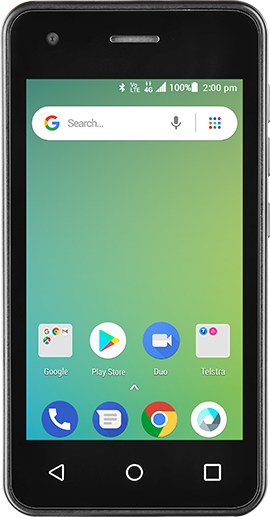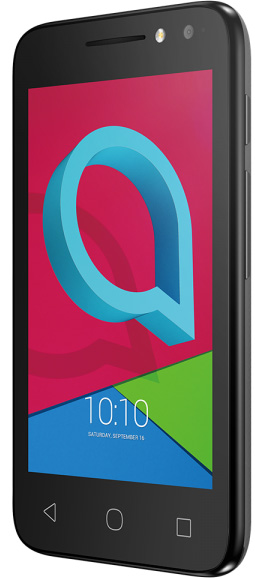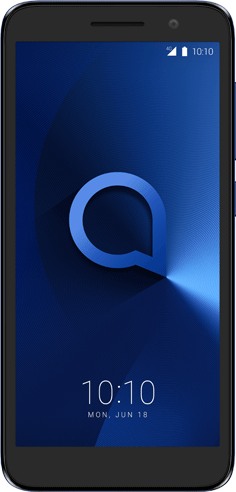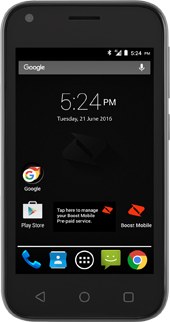If you would like to add more datasheets to the comparison table you can still find and add them around the site while browsing, querying or searching Device Specs. Meanwhile you will not lose the comparison table below. Furthermore unnecassary datasheets can be removed by clicking on the "Remove from comparison" buttons (ever more than one item during one page load) but in this case reloading the table will be needed. Then click again on the appropriate header "Compare" button.
|
|
| | | |
|
Use the following link to refer to this comparison |

| 
| 
| 
|
|
Remove all |
|  Add to compare Add to compare | |  Add to compare Add to compare | |  Add to compare Add to compare | |  Add to compare Add to compare |
 Introduction Introduction |
Brief |
Mini size entry-level smartphone for Boost Mobile MVNO |
|
Low-end smartphone with Android Oreo Go OS for Boost Mobile MVNO |
Mini size entry-level smartphone made by ZTE for Boost Mobile MVNO |
Released |
2018 Dec 31 |
2017 Dec |
2018 Sep 4 |
2017 Feb |
Announced |
2018 Dec 31 |
|
2018 Aug 20 |
|
Hardware Designer |
ZTE |
TCL |
TCL |
ZTE |
Manufacturer |
ZTE |
TCL |
TCL |
ZTE |
General Extras |
Haptic touch feedback |
Haptic touch feedback |
Haptic touch feedback |
Haptic touch feedback |
Device Category |
Smartphone |
Smartphone |
Smartphone |
Smartphone |
 Physical Attributes Physical Attributes |
Width |
65 mm |
64.4 mm |
65.7 mm |
64.6 mm |
Height |
126 mm |
121.3 mm |
137.6 mm |
125 mm |
Depth |
11.65 mm |
9.7 mm |
9.8 mm |
10.8 mm |
| Dimensions
| 2.56x4.96x0.46 inches |
2.54x4.78x0.38 inches |
2.59x5.42x0.39 inches |
2.54x4.92x0.43 inches |
Mass |
125 g |
102 g |
134 g |
127 g |
|
4.41 ounces |
3.6 ounces |
4.73 ounces |
4.48 ounces |
 Software Environment Software Environment |
Platform |
Android |
Android |
Android |
Android |
Operating System |
Google Android 8.1 Oreo Go edition (Oreo) |
Google Android 6.0 (Marshmallow) |
Google Android 8.1 Oreo Go edition (Oreo) |
Google Android 6.0 (Marshmallow) |
Software Extras |
Navigation software |
Navigation software |
Navigation software |
Navigation software |
 Application processor, Chipset Application processor, Chipset |
CPU Clock |
1100 MHz |
1300 MHz |
1280 MHz |
1000 MHz |
CPU |
Qualcomm Snapdragon 210 MSM8909, 2014, 32 bit, quad-core, 28 nm, Qualcomm Adreno 304 GPU |
MediaTek MT6580, 2015, 32 bit, quad-core, ARM Mali-400 GPU |
MediaTek MT6739, 2017, 64 bit, quad-core, 32 Kbyte I-Cache, 32 Kbyte D-Cache, 28 nm, IMG PowerVR GE8100 GPU |
MediaTek MT6735M, 2015, 64 bit, quad-core, 28 nm, ARM Mali-T720 GPU |
 Operative Memory Operative Memory |
RAM Type |
LPDDR3 SDRAM |
LPDDR3 SDRAM |
LPDDR3 SDRAM |
LPDDR3 SDRAM |
|
533 MHz |
|
667 MHz |
533 MHz |
RAM Capacity (converted) |
1 GiB RAM |
|
1 GiB RAM |
1 GiB RAM |
 Non-volatile Memory Non-volatile Memory |
Non-volatile Memory Interface |
eMMC 4.5 |
eMMC 4.5 |
eMMC 5.1 |
Yes |
Non-volatile Memory Capacity (converted) |
8 GB ROM |
8 GB ROM |
8 GB ROM |
8 GB ROM |
|
5100 MiB total user storage |
|
|
3430 MiB total user storage |
 Display Display |
Display Diagonal |
102 mm |
101.6 mm |
125.7 mm |
102 mm |
|
4 inch |
4 inch |
4.9 inch |
4 inch |
Resolution |
480x800 |
480x800 |
480x960 |
480x800 |
Horizontal Full Bezel Width |
12.52 mm |
12.13 mm |
9.49 mm |
12.12 mm |
Display Area Utilization |
56.0% |
58.3% |
69.9% |
56.8% |
Pixel Density |
232 PPI |
233 PPI |
217 PPI |
232 PPI |
Display Type |
Color IPS TFT LCD display |
Color TN-TFT LCD display |
Color TN-TFT LCD display |
Color TN-TFT LCD display |
Number of Display Scales |
16.8M |
16.8M |
16.8M |
16.8M |
Scratch Resistant Screen |
No |
No |
Yes |
No |
 Graphical Subsystem Graphical Subsystem |
Graphical Controller |
Qualcomm Adreno 304 |
ARM Mali-400MP2 |
PowerVR Ge8100 |
ARM Mali-T720 |
Dedicated Graphics Memory |
0.09375 MiB |
|
|
|
| GPU Clock |
|
500 MHz |
450 MHz |
|
 Audio/Video Interfaces Audio/Video Interfaces |
 Audio Subsystem Audio Subsystem |
Microphone(s) |
mono |
stereo |
stereo |
mono |
| Loudspeaker(s) |
mono |
mono |
mono |
mono |
| Loudspeaker Power
| |
|
0.7 W |
|
| Audio Output |
3.5mm |
3.5mm |
3.5mm |
3.5mm |
 Cellular Phone Cellular Phone |
Supported Cellular Bands |
GSM900,
GSM1800,
UMTS2100 (B1),
UMTS850 (B5),
LTE2100 (B1),
LTE1800 (B3),
LTE2600 (B7),
LTE900 (B8),
LTE700 (B28) bands |
GSM900,
GSM1800,
UMTS2100 (B1),
UMTS1900 (B2),
UMTS850 (B5),
UMTS900 (B8) bands |
GSM850,
GSM900,
GSM1800,
GSM1900,
UMTS2100 (B1),
UMTS1900 (B2),
UMTS850 (B5),
UMTS900 (B8),
LTE2100 (B1),
LTE1800 (B3),
LTE850 (B5),
LTE2600 (B7),
LTE900 (B8),
LTE700 (B28),
TD-LTE2600 (B38),
TD-LTE2300 (B40) bands |
GSM900,
GSM1800,
UMTS2100 (B1),
UMTS850 (B5),
LTE2100 (B1),
LTE1800 (B3),
LTE2600 (B7),
LTE700 (B28) bands |
Supported Cellular Data Links |
GPRS,
EDGE,
UMTS,
HSUPA,
HSUPA 5.8,
HSDPA,
HSDPA 7.2,
HSPA+ 21.1,
HSPA+ 42.2,
DC-HSDPA 42.2,
LTE,
LTE 50/25,
LTE 75/25,
LTE 100/50,
LTE 150/50 data links |
GPRS,
EDGE,
UMTS,
HSUPA,
HSUPA 5.8,
HSDPA,
HSDPA 7.2,
HSPA+ 21.1 data links |
GPRS,
EDGE,
UMTS,
HSUPA,
HSUPA 5.8,
HSDPA,
HSDPA 7.2,
HSPA+ 21.1,
HSPA+ 42.2,
LTE,
LTE 100/50,
LTE 150/50 data links |
GPRS,
EDGE,
UMTS,
HSUPA,
HSUPA 5.8,
HSDPA,
HSDPA 7.2,
HSPA+ 21.1,
HSPA+ 42.2,
DC-HSDPA 42.2,
LTE,
LTE 50/25,
LTE 75/25,
LTE 100/50,
LTE 150/50 data links |
SIM Card Slot |
Nano-SIM (4FF) |
Micro-SIM (3FF) |
Nano-SIM (4FF) |
Micro-SIM (3FF) |
Complementary Phone Services |
Voice transmission,
Voice speaker,
Vibrate,
Speakerphone,
VoLTE |
Voice transmission,
Voice speaker,
Vibrate,
Speakerphone,
ANC,
HD Voice |
Voice transmission,
Voice speaker,
Vibrate,
Speakerphone,
ANC,
HD Voice |
Voice transmission,
Voice speaker,
Vibrate,
Speakerphone |
SAR (head) |
1.128 W/kg |
|
|
0.604 W/kg |
SAR (body) |
1.943 W/kg |
|
|
0.763 W/kg |
 Secondary Cellular Phone Secondary Cellular Phone |
 Control Peripherals Control Peripherals |
Touchscreen Type |
Capacitive multi-touch screen |
Capacitive multi-touch screen |
Capacitive multi-touch screen |
Capacitive multi-touch screen |
 Communication Interfaces Communication Interfaces |
Expansion Interfaces |
TransFlash,
microSD,
microSDHC |
TransFlash,
microSD,
microSDHC |
TransFlash,
microSD,
microSDHC |
TransFlash,
microSD,
microSDHC |
USB |
USB 2.0 |
USB 2.0 |
USB 2.0 |
USB 2.0 |
|
USB HS (480 Mbps) |
USB HS (480 Mbps) |
USB HS (480 Mbps) |
USB HS (480 Mbps) |
| USB Services
| USB charging |
USB charging |
USB charging |
USB charging |
| USB Connector
| USB Micro-B (Micro-USB) |
USB Micro-B (Micro-USB) |
USB Micro-B (Micro-USB) |
USB Micro-B (Micro-USB) |
Bluetooth |
Bluetooth 4.0 |
Bluetooth 4.0 |
Bluetooth 4.2 |
Bluetooth 4.0 |
Wireless LAN |
802.11b,
802.11g,
802.11n |
802.11b,
802.11g,
802.11n |
802.11b,
802.11g,
802.11n |
802.11b,
802.11g,
802.11n |
| Wireless Services
| Wi-Fi Tethering |
Wi-Fi Direct,
Wi-Fi Tethering |
Wi-Fi Direct,
Wi-Fi Tethering |
Wi-Fi Tethering |
 Multimedia Broadcast Multimedia Broadcast |
FM Radio Receiver |
FM radio (76-108 MHz) |
FM radio (76-108 MHz) |
FM radio (76-108 MHz) |
FM radio (76-108 MHz) |
 Satellite Navigation Satellite Navigation |
Complementary Satellite Services |
Simultaneous GPS,
A-GPS,
Geotagging,
QuickGPS |
A-GPS,
Geotagging,
QuickGPS |
Geotagging,
QuickGPS |
Simultaneous GPS,
A-GPS,
Geotagging,
QuickGPS |
 Primary Camera System Primary Camera System |
Camera Placement |
Rear |
Rear |
Rear |
Rear |
Camera Image Sensor |
CMOS |
CMOS |
CMOS |
CMOS |
Number of effective pixels |
4.9 MP camera |
4.9 MP camera |
4.9 MP camera |
4.9 MP camera |
Zoom |
1.0 x optical zoom |
1.0 x optical zoom |
1.0 x optical zoom |
1.0 x optical zoom |
|
|
|
|
5.0 x digital zoom |
Focus |
CD AF |
No |
No |
No |
Video Recording |
|
|
1920x1080 pixel |
|
|
30 fps |
30 fps |
30 fps |
30 fps |
Flash |
single LED |
single LED |
single LED |
single LED |
Camera Extra Functions |
Panorama Photo,
Face detection |
HDR photo,
Face detection,
Face retouch |
HDR photo,
Burst mode,
Panorama Photo,
Face detection |
Panorama Photo,
Face detection |
 Secondary Camera System Secondary Camera System |
Secondary Camera Placement |
Front |
Front |
Front |
Front |
Secondary Camera Sensor |
CMOS |
CMOS |
CMOS |
CMOS |
Secondary Camera Number of pixels |
0.3 MP sec. cam |
1.9 MP sec. cam |
1.9 MP sec. cam |
1.9 MP sec. cam |
Secondary Video Recording |
|
|
1280x720 pixel |
|
|
|
30 fps |
30 fps |
|
Secondary Camera Extra Functions |
No |
Face detection,
Face retouch |
No |
No |
 Built-in Sensors Built-in Sensors |
Built-in accelerometer |
Yes |
Yes |
Yes |
Yes |
Additional sensors |
L sensor,
P sensor |
L sensor,
P sensor |
P sensor |
L sensor,
P sensor |
 Ingress Protection Ingress Protection |
Protection from solid materials |
Yes |
Yes |
Yes |
Yes |
Protection from liquids |
Yes |
Yes |
Yes |
Yes |
 Power Supply Power Supply |
Battery |
Li-ion |
Li-ion polymer (LiPo) |
Li-ion |
Li-ion |
|
removable |
built-in |
removable |
removable |
|
1-cell |
1-cell |
1-cell |
1-cell |
Nominal Battery Voltage |
|
|
3.85 Volts |
|
Nominal Battery Capacity |
1600 mAh battery |
1500 mAh battery |
2000 mAh battery |
1600 mAh battery |
Nominal Battery Energy |
|
|
7.70 Wh |
|
| Talk Time |
6.0 hours |
12.0 hours |
17.0 hours |
|
 Geographical Attributes Geographical Attributes |
Market Countries |
Australia,
NZ |
Australia,
NZ |
Australia,
NZ |
Australia,
NZ |
Market Regions |
Australia |
Australia |
Australia |
Australia |
Mobile Operator |
Boost Tel Pty Limited Australia |
Boost Tel Pty Limited Australia,
Telstra Corporation Limited |
Boost Tel Pty Limited Australia |
Boost Tel Pty Limited Australia |
 Datasheet Attributes Datasheet Attributes |
Data Integrity |
Final |
Preliminary |
Final |
Final |
Added |
2019-01-02 23:15 |
2019-01-02 23:28 |
2019-01-03 12:10 |
2019-01-03 12:41 |